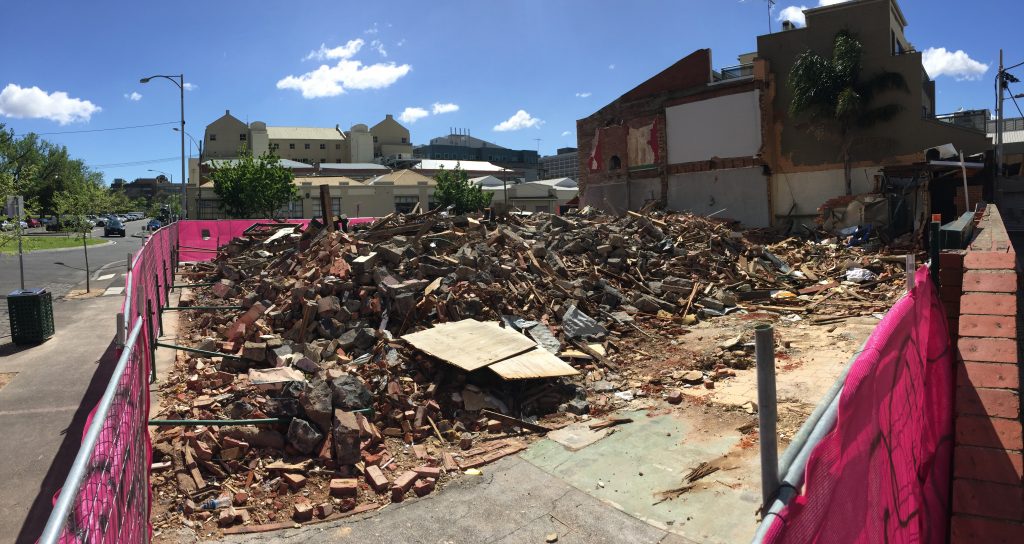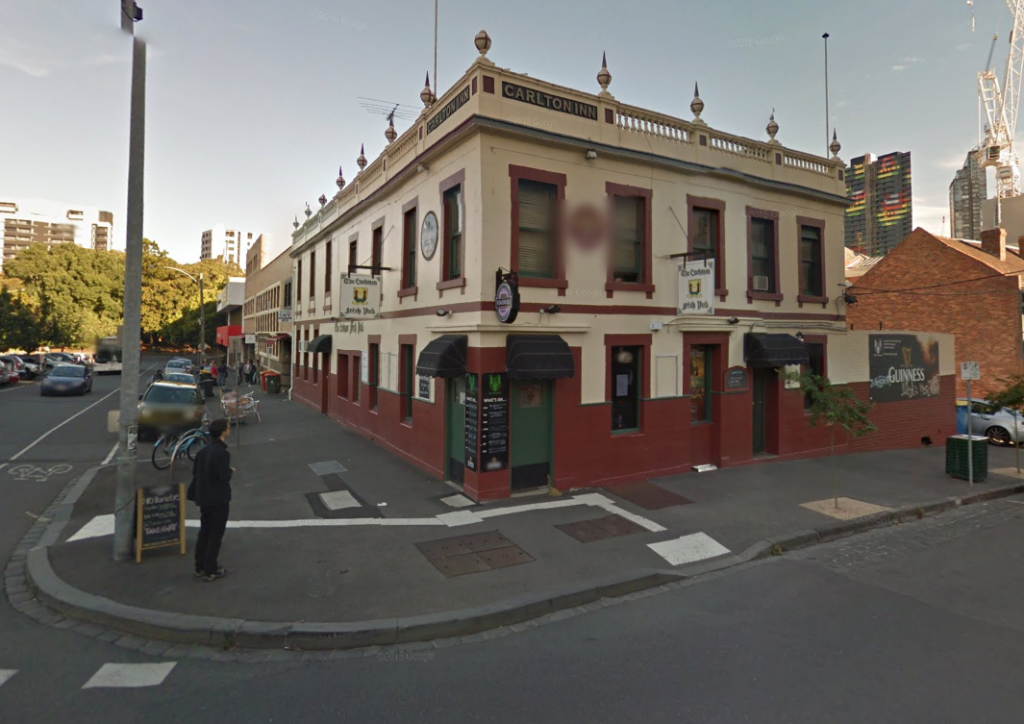The Life and Death of the Carlton Inn

If you want to get away with murder, it’s probably unwise to attempt it in the shadow of a law faculty. But that’s exactly what the owners of the former Corkman Irish Pub (Carlton Inn) did at the weekend, demolishing the historic 1857 pub identified by Melbourne City Council as “one of the earliest extant buildings in this part of Carlton”, opposite Australia’s oldest law school.
Law students from the University of Melbourne have been quick to react, mounting a campaign to “Resurrect the Corkman”. An online petition has gathered over 5,000 signatures in less than 24 hours, with all major (and some minor) news outlets picking up the issue today, and #corkman trending on Twitter.
The most urgent issue to be addressed is that of unlawful demolition. The City of Melbourne has confirmed in a media statement that “neither a planning permit or building permit have been issued for the demolition of the building and there are no approved plans for its future development”, and after being alerted to the demolition on Saturday, issued a stop work notice. Following the demolition, politicians across the political spectrum have united in their calls for the rogue developers to feel the full force of the law. Planning Minister Richard Wynne has said that he has referred the matter to the Victorian Building Authority and will investigate increasing penalties. There are also reports that the EPA, WorkSafe, the CFMEU are also investigating. So it’s fair to say that everyone is onto it, and first and foremost, the National Trust fully supports all relevant inquiries into the demolition, and we hope that Council and other relevant authorities “throw the book” at the alleged perpetrators.
But what no one is talking about is that demolition wasn’t – isn’t – the only threat to the Corkman. A pub is not just bricks and mortar. It’s a gathering place for a community. This quote by a Melbourne University law student, taken from the change.org petition, captures the experience of generations of students:
Yes, the reason why we all went there was because it was ludicrously close to the building in which we spent all of our other waking hours. But that closeness meant that everybody went there. And that everybody went there meant that a community existed. We all made great friendships while getting sloshed in the afternoon in that courtyard.
Hundreds more comments on the petition reveal connections, memories and outrage. But, even if the owner is required to rebuild the pub brick by brick, as many in the community are calling for, there is no guarantee that it will continue to be the public meeting place it has been for the last 159 years.
There are many unknowns about the owner/developer’s intentions for the site, as no planning application has been lodged with the City of Melbourne. What we do know is that the Corkman sold at auction for $4.8m on 30 October 2014, attracting $1,760,000 above the reserve. The advertisement for the sale noted the development potential of the site, stating that vacant possession could be provided in October 2015, upon the expiry of the existing lease.
The site is within the City of Melbourne’s Capital City Zone, with the planning scheme allowing development to 40m, with a 24m street wall (podium) height onto Leicester Street. Any part of the building above 24m must be setback 6m from the street. The scheme also requires new buildings to “respect the rich heritage fabric of the area “. Development on the site is also constrained by its inclusion in the Heritage Overlay (HO85).
But none of these planning controls take into account the community value of the hotel, and others like it. The same story is playing out all over Melbourne – and abroad. Locally, communities have been outraged by the closure of much-loved pubs such as the London Hotel, “The Edgy” in Mentone, and the North Fitzroy Star, while in the UK, The Guardian has reported in depth on the growing trend of pubs falling victim to developers, and the community campaign to save The Golden Lion in Camden.
And while the National Trust has a role in advocating for the best possible development outcomes for these places, we are constrained by the mechanisms for protection which are provided by local planning schemes and the Heritage Act, which are generally limited to the conservation of fabric, not retaining the historic use.
This issue was at the heart of the Trust’s battle with community group Save the Palace to save Bourke Street’s Palace Theatre – to achieve recognition that the Palace’s value is not just as a facade in the streetscape, but as a place of performance, entertainment and enjoyment, characterised by its historic amphitheatre and layered interiors, and documented in its rich social history. At VCAT, the National Trust called an expert on social media to examine the evidence for social significance, a first for the tribunal and an important step towards recognising the importance of community values. Ultimately though, the bid to save the palace was thwarted by inadequate planning controls which do not recognise these values.
So what is the way forward? How can communities protect the amenity provided by places like the Corkman (once it has been rebuilt)? One way is to buy them. In 2015 the University of Melbourne bought the historic Prince Alfred Hotel in Carlton (at a cost of $4.5m) to ensure “a continuity of student amenity”. In 2011, a syndicate of 10 locals chipped in to rescue the Aireys Inlet Hotel. But in an open market driven by property developers, purchasing the site isn’t always a practical or sustainable solution. So how can developers and property owners be encouraged to continue historical uses and provide public amenity on private property?
What do you think? Please let us know in the comments section below. For media enquiries contact Felicity Watson, Senior Community Advocate.


So I guess then the best result would be for it to be rebuilt pretty much as it was, with all the things altered over time, and that a good proportion of the ground floor be used as a cheap and cheerful pub, given to the University ! The owner can get to keep the rest of the site, about half, after paying for all that, and develop whatever the City of Melbourne and VCAT will allow.
This is a disgraceful outcome. We need to know who these people are who think they can just ignore the law and get rich from illegal development. They should lose money by (a) being fined and (b) being given the most rigorous possible development scrutiny, and perhaps (c) being forced to rebuild the pub (al though I doubt that this would happen). But first, they must be named and shamed so that community outrage has a target.
Yes poor form, greedy developers they should be dealt with harshly as deserved. I am not sure if you heard what Kinki Gerlinki ave done with their property in Sydney Road but worth a look. They have made an agreement with a co-housing group, to save it from the general greedy riff raft and have secured themselves a new shop and dwelling, and a new community. Sounds like a win win!
Hi Felicity, Clearly the mood is to punish the wreckers and take back the site for the community. Thinking about how to go about it, there seems a likely barrier. The owners/demolishers are potentially going down the bankruptcy route or wheedle out of either restitution or even paying fines. So we may be left with a bomb site and no funds to get the building back. Is there any recourse to seizure of assets, freeze or company trading, or some other way of making it unattractive for them to do anything other than rebuild exactly as it was and sell?
Want to see how I feel ? check out “Last Round At The Pub” on my blog Nompie.wordpress.com
The future cost for the community of this brazen demolition has not been considered. In 20 plus years it could run to billions.
This demolition is atrocious. Especially now that we realize that the locals community, the University students (Melbourne Business School, The Law School, The Economics and Commerce school) , the staff and the lecturers, and others who live in the area have been breathing in asbestos fibres over the last five days.
You may or may not be aware that asbestos needles are very fine and with the recent very windy conditions even patients at the RMH may end up sicker then when they got there. Certainly hundreds of people would be affected by this demolition.
No they will not get sicker immediately but in twenty or so years they may get cancer – one of the worst cancers – the incurable mesothelioma! This is a slow very painful condition to die from.
It is a terrible thing that has been done.
And we needed to respond properly!
0418 557446
For this to happen in the city I love so much, because of places just like The Corkman, is terrifying. They need to be told to rebuild the pub to exactly how it was, no compromise, so it sets precedent for others thinking of doing the same. Melbourians know how to handle cowboys who think they can steal from us for their own good – Chloe still hangs at Young & Jackson!
The developers should not be allowed to get away with the demolition. start with large fines, including those for dumping hazardous waste on a residential block, force the rebuilding or loss of the block without compensation and put serious controls on all their developments for the foreseeable future. I do not see bankruptcy as a real problem provided that they do not get access to the property or the proceeds of a subsequent sale. they are OOP by around $5m which will be increasing by the day as interest on any loans or loss of profit if there are not any loans. There is a lot of support among by golfing buddies for serious penalties etc..
this old pub was probably made using bricks that were hand made and fired in an open clamp using wood as the fuel. The bricks were probably then laid in a lime mortar made from rock limestone found on the Mornington peninsula that was also burnt using timber as the fuel. In the UK, the brick manufacturer HG Mathews is once again making wood fired bricks in a traditional open brick clamp. Wood fired bricks are also made in the USA. These jokers who pulled down the pub should be made to remake the lost traditional bricks and then rebuild the pub using traditional lime mortars and renders, baltic pine floors, windows and doors and no doubt a slate roof